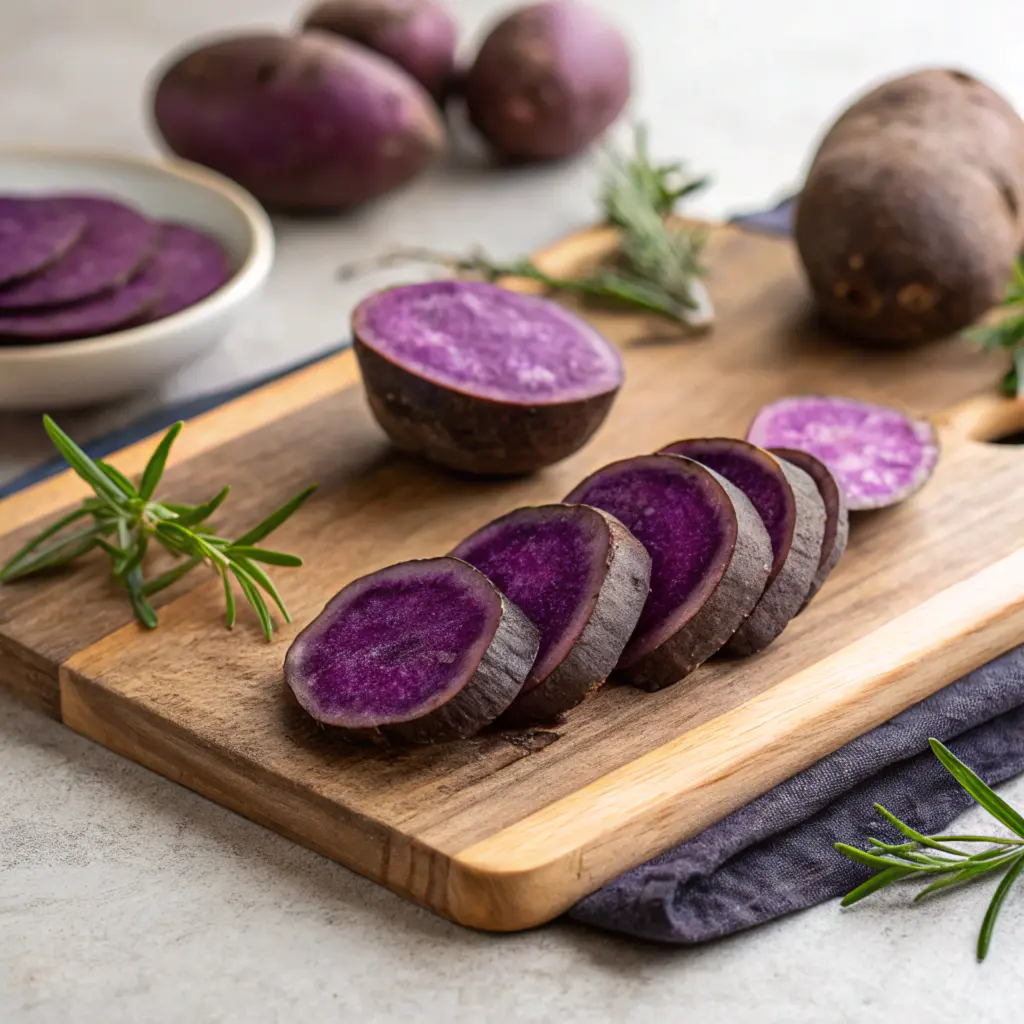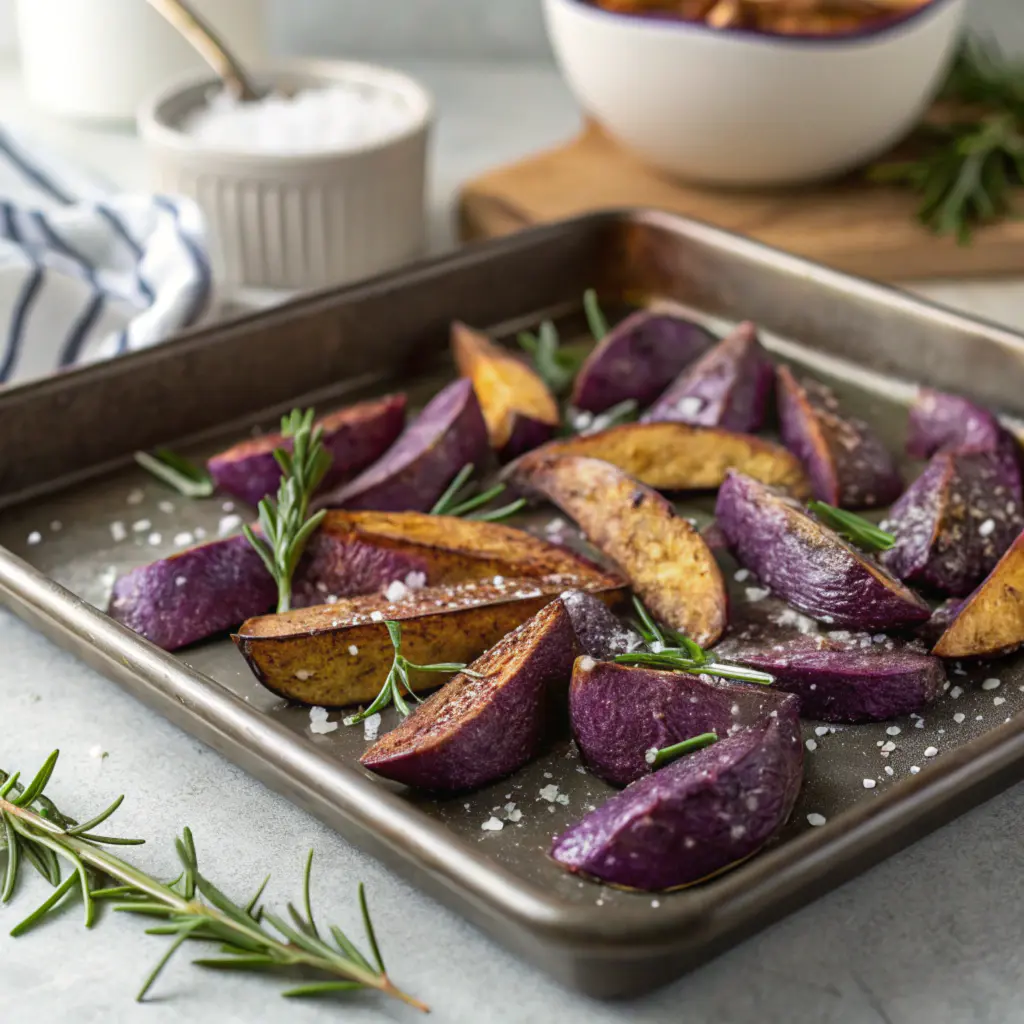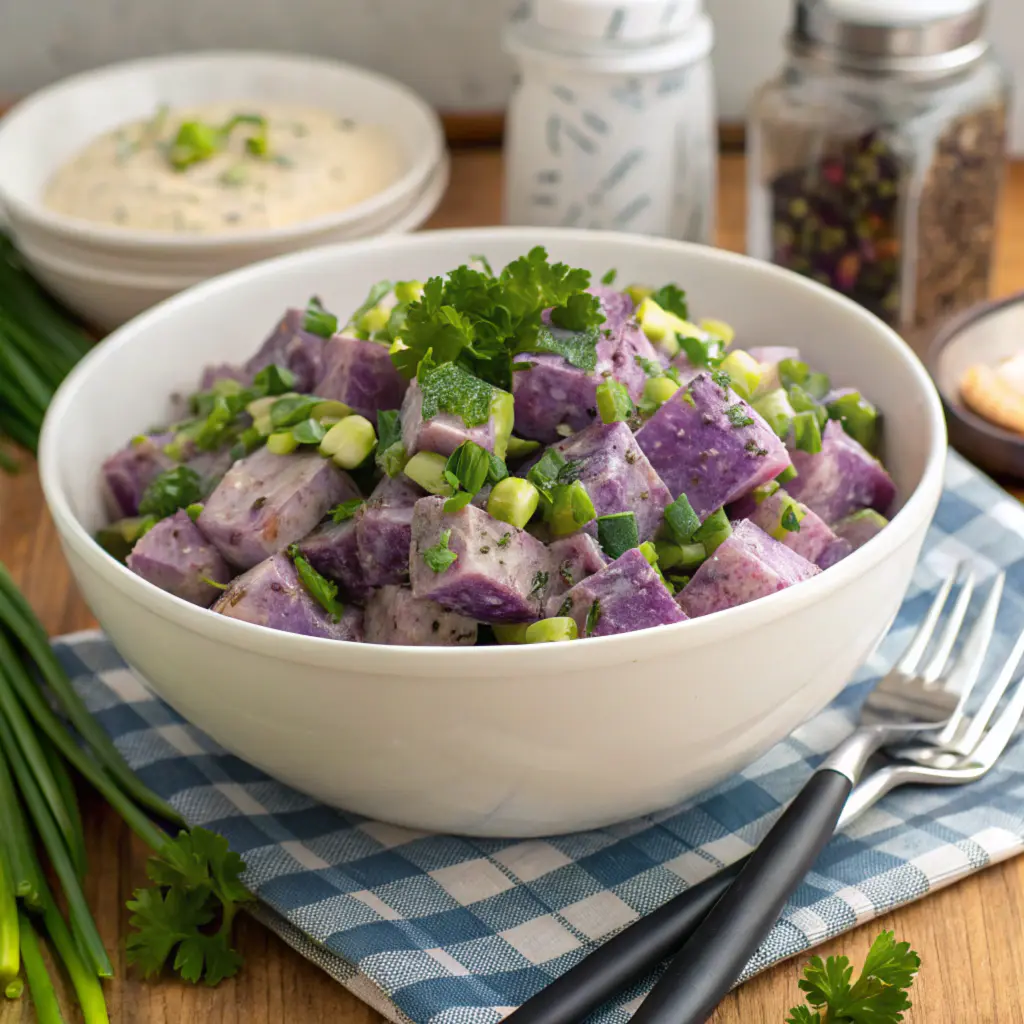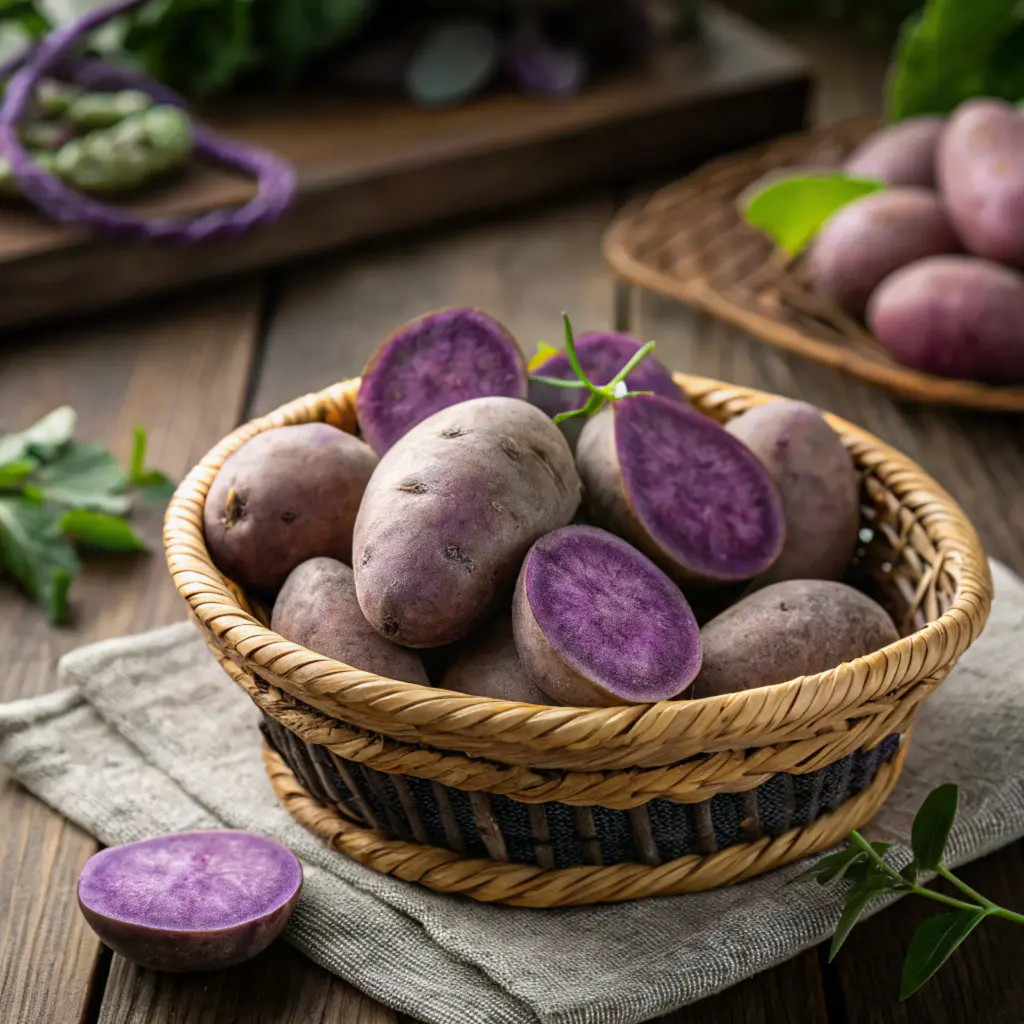Introduction
Purple potatoes are more than just pretty vegetables. They are packed with nutrients and health benefits. Their bright purple color comes from natural plant compounds called anthocyanins, which are strong antioxidants. These compounds help fight inflammation and protect the body from damage caused by free radicals.
Originating in the Andes Mountains of South America, purple potatoes have been around for hundreds of years. Farmers first grew them for their rich taste, long storage life, and natural health properties. Today, they are popular worldwide for their flavor, nutrition, and visual appeal.
Purple potatoes are versatile and easy to use in recipes. They can be baked, roasted, mashed, or boiled. They also make colorful additions to soups and salads. Their earthy flavor pairs well with spices, herbs, and other vegetables.
Eating purple potatoes may help lower blood pressure, improve digestion, and boost energy. They’re also low in fat and high in fiber, making them a smart choice for weight management. Whether you’re looking to improve your health or try something new, purple potatoes are a great option.
This article will explore everything about purple potatoes—from their health benefits and varieties to tips for cooking and growing them. Ready to learn more? Let’s dive in!
What Are Purple Potatoes?
A Unique and Colorful Crop
Purple potatoes are a type of root vegetable with a deep purple or blue color. They stand out because of their vibrant skin and flesh. Their color comes from natural pigments called anthocyanins, which also give blueberries and red cabbage their shades.
These potatoes are native to South America. Farmers in the Andes first grew them thousands of years ago. Over time, their popularity spread to other regions. Today, they are grown in many countries and are widely available in grocery stores and farmers’ markets.
Distinctive Appearance and Taste
Purple potatoes have a firm texture and a slightly nutty flavor. Some people describe their taste as earthy and rich. Their color stays bright even after cooking, making them a fun and eye-catching ingredient in meals.
They come in different shapes and sizes. Some varieties are round, while others are more oval. The skin can be smooth or slightly rough, depending on the type.
Natural and Non-GMO
Despite their unusual look, purple potatoes are completely natural. They are not genetically modified. Their color is the result of natural breeding and evolution over many generations.
Nutritional Value of Purple Tubers: Vitamins and Benefits

Packed with Vitamins and Minerals
Purple potatoes are packed with antioxidants, vitamins, and fiber. Their high levels of anthocyanins help fight inflammation and protect cells from damage. Studies have shown that antioxidants may reduce the risk of chronic diseases, including heart disease and cancer. For more information on the health benefits of antioxidants, visit Medical News Today.
These potatoes provide vitamin B6, which helps the body produce energy. They also have small amounts of iron and magnesium, which play key roles in overall health.
High in Antioxidants
One of the best features of purple potatoes is their antioxidant content. The anthocyanins in their flesh act as powerful antioxidants. These compounds help reduce inflammation and protect cells from damage caused by free radicals.
Eating foods rich in antioxidants can lower the risk of chronic illnesses, including heart disease and certain cancers. Purple potatoes are a simple way to add these benefits to your diet.
Low in Calories, High in Fiber
Purple potatoes are naturally low in calories, making them a healthy option for weight control. A medium-sized potato has about 120 calories.
They are also high in fiber, which supports digestion and helps you feel full. Fiber slows down the absorption of sugar, which may help regulate blood sugar levels.
A Good Source of Complex Carbs
These potatoes provide complex carbohydrates, which offer steady energy. Unlike simple sugars, complex carbs take longer to digest. This helps maintain energy levels and reduces sudden hunger.
Top Health Benefits of Purple Potatoes for Heart and Digestion
Supports Heart Health
Purple potatoes may help keep the heart healthy. Their potassium content helps lower blood pressure by relaxing blood vessels.
The antioxidants in these potatoes may also reduce bad cholesterol levels. Lower cholesterol improves blood flow and reduces the risk of heart disease.
Reduces Inflammation
Inflammation is linked to many health problems, including arthritis and diabetes. Purple potatoes contain compounds that fight inflammation. Eating them regularly may help ease swelling and pain.
Boosts Immunity
Vitamin C in purple potatoes helps strengthen the immune system. It supports the production of white blood cells, which fight infections.
Improves Digestion
The fiber in purple potatoes helps promote gut health. It feeds good bacteria in the intestines and prevents constipation. A healthy gut can also improve nutrient absorption.
May Prevent Chronic Diseases
The antioxidants in purple potatoes may protect the body from damage that leads to diseases like cancer. Studies show that anthocyanins may block the growth of cancer cells.
Aids in Weight Control
Purple potatoes are filling but low in calories. They make you feel satisfied without overeating. Their fiber content slows digestion, keeping you full for longer periods.
Popular Varieties of Purple Potatoes
Different Types for Every Taste
Purple potatoes come in several varieties. Each type has its own flavor, texture, and cooking style. Some are better for mashing, while others work well for roasting or frying. Knowing the differences can help you pick the right one for your recipe.
Purple Majesty
Purple Majesty is one of the most popular types. It has smooth, dark purple skin and bright purple flesh. Its texture is creamy, making it perfect for mashed potatoes or soups.
This variety is also rich in antioxidants. It holds its color after cooking, so it looks beautiful on the plate.
All Blue
All Blue potatoes have blue-purple skin and slightly lighter flesh. They have a firm texture, which makes them great for salads or roasting.
Their mild flavor pairs well with spices and herbs. Because they stay firm after boiling, they are often used in potato salads.
Vitelotte
Vitelotte potatoes are an old variety from France. They have a nutty flavor and a dense, waxy texture. These potatoes are ideal for roasting, frying, or making chips.
They are smaller than other types but pack a lot of flavor. Their deep purple color makes them popular in gourmet dishes.
Adirondack Blue
Adirondack Blue potatoes have a slightly sweeter taste. They are soft and moist, so they work well in mashed or baked dishes.
Their light purple flesh fades a little when cooked, but they still keep most of their color.
Which Variety Should You Choose?
Each variety has its own strengths. If you need potatoes for salads, try All Blue. For soups or mashing, go with Purple Majesty. Roasting or frying? Vitelotte is a great choice.
No matter which one you pick, all purple potatoes are nutritious and tasty.
Cooking Ideas for Purple Potatoes and Vibrant Recipes

Simple Ways to Prepare Them
Purple potatoes pair well with many side dishes, especially comfort foods. For example, roasted purple potatoes with garlic and rosemary can be served alongside classic baked beans for a hearty meal. If you’re looking for a delicious baked beans recipe, check out this homemade baked beans recipe to complement your dish.
Boiling for Salads
Boiled purple potatoes are great for salads. To keep their color, boil them whole with the skin on. Once cooked, cool them and cut into chunks.
Add olive oil, lemon juice, and fresh herbs for flavor. Toss in some onions or cucumbers for crunch.
Roasting for Crispiness
Roasting brings out their natural sweetness. Cut the potatoes into wedges or cubes. Toss them with olive oil, garlic, and rosemary.
Spread them on a baking sheet and roast at 400°F for 25-30 minutes. Flip halfway through to make sure they cook evenly.
Mashing for Comfort Food
Mashed purple potatoes are creamy and colorful. Boil them until tender, then mash with butter and milk. Add salt, pepper, and garlic for extra taste.
For a vegan option, use plant-based butter and almond milk.
Baking for a Healthy Option
Baked purple potatoes are simple and filling. Wash and poke holes in the skin to let steam escape. Bake at 425°F for about 45 minutes.
Serve them with sour cream, chives, or melted cheese.
Creative Recipe Ideas
Purple potatoes work well in soups and stews. Their vibrant color makes them perfect for layered salads. You can also use them in casseroles or breakfast hash.
For something unique, try purple potato chips. Thinly slice the potatoes and bake them with a little olive oil and sea salt.
How to Grow Purple Potatoes at Home

Easy to Grow in Any Garden
Purple potatoes are simple to grow, even for beginners. They adapt well to most soils and climates. With a little care, you can enjoy fresh, colorful potatoes right from your garden.
Choose the Right Spot
Purple potatoes need full sun. Pick a spot that gets at least 6 hours of sunlight each day. Good drainage is also important since too much water can cause rot.
Prepare the Soil
Loose, well-drained soil works best. Add compost or organic matter to improve nutrients. Avoid clay-heavy soil, as it holds too much water.
Planting the Seed Potatoes
Buy certified seed potatoes to avoid disease. Cut larger potatoes into pieces, making sure each piece has at least one “eye.” Let them dry for a day before planting.
Dig trenches about 4 inches deep. Place the seed potatoes with the eye facing up. Space them 12 inches apart and cover them with soil.
Watering and Care
Keep the soil moist but not soaked. Water deeply once or twice a week, especially during dry weather. Add mulch to retain moisture and keep weeds away.
When the plants start growing, add more soil around the base to protect the tubers. This process, called “hilling,” prevents sunlight from turning the potatoes green.
Harvesting and Storage
Purple potatoes are ready to harvest about 90-120 days after planting. Once the leaves turn yellow and die back, stop watering. Carefully dig up the potatoes with a garden fork.
Let them dry for a few hours before storing. Keep them in a cool, dark place to prevent sprouting.
Purple Potatoes vs. White Potatoes
How Do They Compare?
Purple and white potatoes may look different, but they share some similarities. Both are starchy, filling, and versatile. However, purple potatoes offer added health benefits.
Nutritional Differences
Purple potatoes are higher in antioxidants due to their color. They also contain more potassium, which helps lower blood pressure. White potatoes, on the other hand, are slightly lower in calories.
Purple potatoes have a lower glycemic index, meaning they cause smaller spikes in blood sugar. This makes them a better choice for people with diabetes.
Taste and Texture
White potatoes are softer and creamier when cooked. Purple potatoes have a firmer texture and a slightly nutty flavor. Their rich taste pairs well with herbs and spices.
Cooking Uses
Both types work well for boiling, baking, and roasting. Purple potatoes stand out in salads and side dishes because of their color. White potatoes are often used in mashed dishes and soups.
Which One Should You Choose?
It depends on your needs. For visual appeal and extra nutrition, go with purple potatoes. If you prefer a milder flavor, stick with white ones.
Buying and Storing Purple Potatoes
Picking the Freshest Potatoes
Look for firm potatoes with smooth skin. Avoid any with soft spots, cuts, or wrinkles. Bright, even coloring is a sign of freshness.
Small to medium-sized potatoes are often tastier and cook faster. Larger ones may have a tougher texture.
Organic vs. Conventional
Organic purple potatoes are free from chemicals and pesticides. They may cost more, but many people prefer them for health reasons. Conventional potatoes are fine as long as you wash them well before cooking.
How to Store Them Properly
Keep purple potatoes in a cool, dark place. A pantry or basement works well. Avoid storing them in the fridge, as cold temperatures can make them taste sweet and gritty.
Use a paper or mesh bag instead of plastic. This prevents moisture buildup, which can cause rotting. Check them regularly and remove any that start to spoil.
How Long Do They Last?
Purple potatoes can last up to 2-3 weeks at room temperature. In cooler storage areas, they may last a month or more. Once cooked, keep leftovers in the fridge and eat them within 3-4 days.
Purple Potatoes in Global Dishes

Popular Around the World
Purple potatoes can also be a colorful addition to casseroles and layered dishes. Their nutty flavor blends well with rich and cheesy recipes. Try adding them as a side dish with this flavorful mac and cheese meatloaf casserole for a satisfying and comforting dinner.
South American Roots
In Peru, where purple potatoes began, they are boiled, mashed, or roasted. They are often served as sides with meats or in stews.
European Dishes
In France, purple potatoes are popular in gourmet recipes. Chefs often use them in layered salads, tarts, and soups. Their color makes dishes look elegant.
Asian Fusion Recipes
In Asian cooking, purple potatoes appear in desserts and snacks. They are steamed, mashed, and added to sweet buns or pastries.
North American Favorites
In the U.S. and Canada, purple potatoes are often roasted or mashed. They also show up in potato salads and casseroles.
Creative Ideas to Try
Purple potatoes are perfect for homemade chips and fries. Their color makes them stand out at parties and events. You can also use them to make colorful mashed potatoes or bake them into pies and gratins.
Are Purple Potatoes Diet-Friendly?
Good for Gluten-Free and Vegan Diets
Purple potatoes are naturally gluten-free. They are safe for people with gluten intolerance or celiac disease. Vegans also enjoy them as a plant-based food option.
Low Glycemic Index
These potatoes have a lower glycemic index than white potatoes. This means they release sugar into the blood more slowly, making them a better choice for people with diabetes.
Weight Loss Support
Purple potatoes are high in fiber and low in fat. They help you feel full longer, which can prevent overeating. Their nutrients also support digestion and metabolism.
Rich in Nutrients
Because they are packed with vitamins and antioxidants, purple potatoes fit into balanced diets. They provide energy without adding too many calories.
FAQs
Are Purple Potatoes Healthier Than Regular Potatoes?
Yes, purple potatoes have more antioxidants than white or yellow ones. Their rich color comes from anthocyanins, which help reduce inflammation and protect cells. They also have more potassium, fiber, and vitamins.
What Gives Purple Potatoes Their Color?
Their color comes from natural plant pigments called anthocyanins. These are the same compounds found in blueberries and red cabbage. They are known for their antioxidant and anti-inflammatory effects.
Can You Eat Purple Potatoes Raw?
It’s not recommended. Raw potatoes can be hard to digest. Cooking breaks down starches, making them softer and easier to eat.
Are Purple Potatoes Genetically Modified?
No, purple potatoes are completely natural. They were developed through selective breeding, not genetic modification. Their color is a result of natural plant compounds.
How Long Do Purple Potatoes Last?
Fresh purple potatoes can last 2-3 weeks if stored in a cool, dark place. In colder storage, they may last up to a month. Cooked potatoes should be eaten within 3-4 days.
Do Purple Potatoes Taste Different?
Yes, they have a slightly nutty and earthy flavor. Their taste is richer than white potatoes but still mild enough to use in many dishes.
Conclusion
Purple potatoes are a colorful and healthy choice for any diet. They are packed with antioxidants, fiber, and important vitamins. Their bright color makes them stand out, while their rich flavor works in many recipes.
These potatoes can help lower blood pressure, fight inflammation, and support digestion. They’re also easy to grow and store, making them a great option for home gardens.
Whether roasted, mashed, or added to salads, purple potatoes bring nutrition and style to your table. Try them today and enjoy their taste and health benefits.

